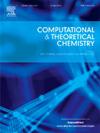Electronic and structural effects of MgO(100) support on CO adsorption in coinage metal hexamers
IF 3
3区 化学
Q3 CHEMISTRY, PHYSICAL
引用次数: 0
Abstract
We present a comprehensive DFT investigation of CO adsorption on six-atom coinage metal clusters (Cu6, Ag6, Au6) and their bimetallic analogues (Ag3Cu3, Au3Cu3, Au3Ag3), both in the gas phase and supported on a MgO(100) surface. Global optimization techniques were employed to identify the most stable geometries. Upon adsorption, pronounced structural rearrangements emerge, particularly in Cu-containing systems, leading to planar-to-3D transitions that enhance orbital hybridization with the CO molecule and modulate charge transfer pathways. Adsorption energies, projected density of states (PDOS), and Bader charge analysis confirm significant support-induced electronic reorganization. Among the studied systems, Ag3Cu3 supported on MgO exhibits the most favorable sensing performance, with a recovery time of 2.39 × 10−5 s and moderate adsorption strength. Overall, the MgO(100) support enhances charge donation to the clusters and stabilizes the adsorbed species, thereby improving sensor response in the supported configurations. These results highlight the critical role of cluster geometry, composition, and support in tuning adsorption behavior and gas sensing performance in coinage metal clusters.

MgO(100)载体对铸币金属六聚体CO吸附的电子和结构影响
本文对六原子铸造金属团簇(Cu6, Ag6, Au6)及其双金属类似物(Ag3Cu3, Au3Cu3, Au3Ag3)在气相和MgO(100)表面上的CO吸附进行了全面的DFT研究。采用全局优化技术确定最稳定的几何形状。吸附后,明显的结构重排出现,特别是在含cu的体系中,导致平面到三维的转变,增强了与CO分子的轨道杂化,并调节了电荷转移途径。吸附能、投射态密度(PDOS)和Bader电荷分析证实了显著的支持诱导电子重组。其中MgO负载Ag3Cu3表现出较好的传感性能,恢复时间为2.39 × 10−5 s,吸附强度适中。总的来说,MgO(100)支持增强了对簇的电荷捐赠,并稳定了吸附物质,从而改善了支持构型下传感器的响应。这些结果强调了簇的几何形状、组成和支持在调节金属簇的吸附行为和气敏性能方面的关键作用。
本文章由计算机程序翻译,如有差异,请以英文原文为准。
求助全文
约1分钟内获得全文
求助全文
来源期刊

Computational and Theoretical Chemistry
CHEMISTRY, PHYSICAL-
CiteScore
4.20
自引率
10.70%
发文量
331
审稿时长
31 days
期刊介绍:
Computational and Theoretical Chemistry publishes high quality, original reports of significance in computational and theoretical chemistry including those that deal with problems of structure, properties, energetics, weak interactions, reaction mechanisms, catalysis, and reaction rates involving atoms, molecules, clusters, surfaces, and bulk matter.
 求助内容:
求助内容: 应助结果提醒方式:
应助结果提醒方式:


